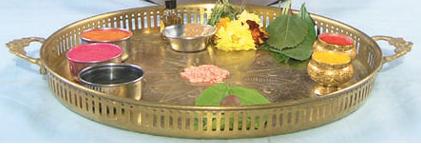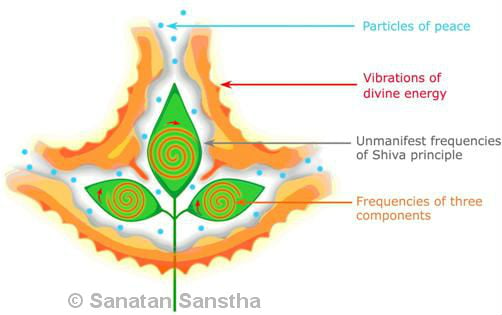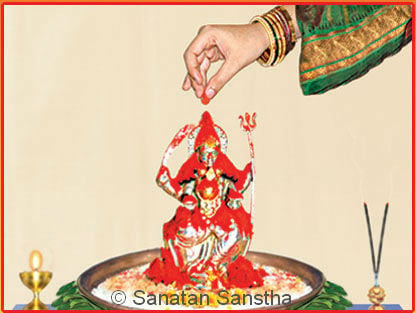Namaskar! We heartily welcome you all for this Satsang (spiritual meet)! Before we commence this Satsang let us pay obeisance at the Holy feet of Sadguru (spiritual master) so that by His grace the very objective of this Satsang is fulfilled. Please pay mental obeisance to your personal icon of faith and recite as follows:
गुरुर्ब्रह्मा गुरुर्विष्णु गुरुर्देवो महेश्वर: ।
गुरु साक्षात् परब्रह्म तस्मै श्री गुरवे नम: ।।
Some of the rituals do not get completed without the help of other ingredients. For example in puja (ritualistic worship) of a deity the materials required are very essential. These ingredients which are complimentary to the rituals play an important role in God realization.When we learn their spiritual significance, bhav or spiritual emotion is generated in our mind and the religious and social rituals are performed with even more bhav.
When the puja materials are arranged in a correct method there is generation of divine consciousness or chaitanya which benefits the worshipper on a spiritual level. Keeping this objective in mind we shall try to describe in this Satsang the spiritual importance and characteristics of ingredients of puja materials such as haldi (turmeric powder), kumum (vermillion), sandalwood paste,Akshata (unbroken rice grains) etc.
Let us first get acquainted with the arrangement of puja materials in a puja platter.
1. Arrangement of puja materials in puja platter
Every object in this universe is made up of five cosmic elements like Earth, water, fire, air and ether or space.Therefore if the arrangement of puja material is done on the basis of these elements then it helps in balancing and regulating the activated five cosmic elements in the universe. The worshipper then gets the maximum benefit both manifest and unmanifest frequencies emitted from the deities. We shall learn about this arrangement with the help of a drawing.
 |
This is a drawing of the puja platter when seen form above. Assuming that the platter is in front of worshipper let us try to understand the arrangement. On a puja platter the turmeric powder is kept to the right side of worshipper withkumkum to its front while bukka, gulal and sindoor are kept on the left side of worshipper. Some of the readers may not be knowing the word bukka. It is a black powder prepared from tela metal. It is used in the puja ritual in some of the regions of our country for example Varkari sect of Maharashtra.
In the front portion of puja platter is kept a botlle of attar (fragrant essence of flowers) and just behind it a small plate containing sandalwood paste. Flowers and leaves are kept in a space between kumkum and the bottle of attar. (The deities are present in the universe in the form of principles and they work through the medium of subtle frequencies).
The subtle vision obtained with the help of spiritual practice introduces us to the activities taking place in the subtle world. Those seeker who have developed such vision by the grace of God have prepared such subtle drawings. The vibrations shown in the drawing being part of spiritual experience are actually three dimensional in nature but in a drawing such as this they are seen in a two dimensional form.
2. Bel leaf (bilva patra)
 |
We are looking at the subtle drawing of Bel leaf which is regularly used in the worship of Lord Shiva.
The nirgun or unmanifest (subtle most) frequencies of Lord Shiva present in the universe are attracted towards the Bel leaf.
These frequencies then activate the three components in every bel leaf in the form of circular and outpouring frequencies. The three components are sattva, raja and tama.
Orange coloured vibrations of divine energy are emitted from the bel leaf into the surrounding atmosphere.
Particles of peace are also simultaneously emitted.
The subtle drawing of a bel leaf must have helped you to understand that how through the medium of a bel leaf a worshipper receives Shiva principle and how because of increased Shiva principle the purity of the atmosphere increases. These are the effects happening on a subtle level. You must also have realized the importance of inclusion of leaves in puja materials. Now let us move on to the next article of puja that is Pan-Supari or betel leaf and betel nut.
3. Betel leaf and betel nut
Betel leaf and betel nut is powerful media of transmitting the frequencies of deities. On a platter of puja materials betel leaf and betel nut are kept along with dakshina (coins) on the backside that is towards worshipper. The tip of the leaf should be towards the worshipper and the stem should face in front. The colour particles present in the leaf and the water particles present in the betel nut attract the subtle frequencies of deities towards them. The rice grains smeared with kumkum are kept in the center of the platter. Thus we have seen the articles of a puja platter, its method of decoration and the resultant effects. Now let us learn in details about some of the ingredients and there spiritual significance. So let us start with turmeric powder.
4. Turmeric (haldi) powder
Haldi has got its own special fragrance. The powder of dried Haldi is used in puja. We can realize its importance more clearly if we come to know its effects in subtle dimension.
The frequencies of deities present in the atmosphere get attracted in haldi
This activates energy predominant in raja-tama components in the form of circles.
This energy is then projected in the atmosphere
Haldi has more amount of earth element in it. Therefore the energy is also transmitted via its fragrance in the surrounding atmosphere.
Haldi has large amount of earth frequencies. Besides earth frequencies it has also got the capacity to attract Lord Ganesh principle. This is all about haldi. Now let us move to next topic that is kumkum (vermillion).
5. Vermillion (kumkum)
Pure kumkum is prepared from haldi itself. Pure haldi powder is mixed with decanted solution of lime (chuna) and little pure camphor and we get pure kumkum. We can identify haldi by its fragrance but once kumkum is ready haldiloses its fragrance completely. A new divine fragrance is developed in the kumkum and it then spreads all over for a certain distance. Here it would be useful for us to know about identification of pure kumkum.
The pure kumkum appears dry in spite of containing moisture and its touch is ice cold. In subtle dimension:
The divine energy present in the kumkum is activated and emitted.
This energy then moves in all directions in circular fashion.
Simultaneously the chaitanya present in the kumkum is also emitted.
Thus the kumkum has a special spiritual significance because of its property of constant emission of divine energy and divine consciousness.
As it is prepared from haldi it contains large proportion of earth frequencies just as in haldi.
Because of its red colour it has more capacity to attract Durga devi principle.
The divine energy present in the kumkum purifies the vital air body and mental body of the worshipper.
The negative energies cannot enter in the worshipper because of its application on the midbrow.
In the ritualistic worship of Devi (Divine enrgy) use of haldi and kumkum have special importance. The kumkum is offered to Devi while chanting her mantra or thousand names. This is known as Kumkumarchan.
 |
6. Gulal
We are all familiar with Gulal. From the point of view of Spiritual science the Divine energy principle from the universe gets attracted to the frequencies of fragrance generated from Gulal. The dormant frequencies laden with chaitanyaacquire momentum due to Gulal and impart spiritual benefit to the worshipper.
7. Sandalwood
Among the various sub rituals offered to the deity in a puja ritual tilak or mark on the forehead with sandalwood paste is also applied to the image of a deity. Application of tilak is one of the five main sub rituals of a deity worship. The sandalwood is scrubbed into a paste before use for applying tilak. But the method of scrubbing should be spiritually correct to be of real spiritual benefit. Therefore let us see the correct method of scrubbing sandalwood.
Hold the piece of sandalwood with both hands. It is often seen that we scrub the piece of sandalwood with one hand while the other hand holds the scrubber. But it is spiritually scientific to hold it with both hands while scrubbing. From the spiritual standpoint this has three important reasons
For accomplishment of any task it is necessary to combine both Shiv (Pure consciousness) and Shakti (divine energy). The left hand is representative of Shiv while right hand is symbolic of Shakti. Therefore it is necessary to use both hands while scrubbing.
Scrubbing by both hands is symbolic of devotion with expectation in duality. Duality means conviction that I am different from God. Devotion with expectation means worshipping God for fulfilling any desire in our life.
While scrubbing sandalwood with both hands forms a characteristic mudra of the body. Mudra means a specific posture of body or its limbs which leads to movement of subtle energy in the body as well as its reception and projection. This activates Sushumna channel among the three main channels of body. This channel is conducive to the spiritual progress of the individual. This is the third reason why it is important to scrub the sandalwood with both hands.
The sandalwood paste thus obtained is kept in a small plate. It is never taken in the hand or kept in a copper vessel. The sandalwood paste retains its fragrance even after it becomes dry. Therefore the the deity principle is present in the tilak applied to the image even after it becomes dry. Sandalwood and ashtagandha attract deity principle in large proportion because of their fragrance. The principles are also retained for a longer period. That is the reason of sandalwood and ashtagandha being maximally sattvik. In the subtle dimension we can see yellow chaitanya being emitted from all sides of the sandalwood piece. The pink coloured bliss frequencies are getting emitted from its four corners.
Ashtagandha is equal to sandalwood in sattvik attribute. It has more proportion of fragrant materials which gives it more capacity to attract the deity principles.
7.1 Why it is incorrect to mix haldi and kumkum while scrubbing sandalwood?
It has been observed sometimes that some people mix haldi and kumkum with sandalwood paste while scrubbing. Is this correct from spiritual science point of view? No. let us see why.
Haldi and kumkum emit frequencies rich in raja component. When we mix haldi and kumkum with sandalwood while it is being scrubbed, the sattva particles present in the sandalwood start to separate from each other. This destroyssattvik attribute of sandalwood. In fact due to haldi and kumkum it becomes dominant in raja component. It also reduces its capacity to attract the frequencies of deities. Thus the worshipper does not get the adequate benefit. Hence the reason that haldi and kumkum should not be mixed with sandalwood.
8. Akshata
Various substances are used in the puja ritual with an objective of attracting deity principles on a large scale and within a short period. Thus the worshipper is maximally benefitted. However if all the substances are not available daily, there is one ingredient which lets us receive all the benefits of a puja ritual and that is Akshata. This is an important ingredient of puja material. Let us now know it in details
This is an important ingredient of puja ritual which absorbs all the deity principles in it. That is why it given a central place on the platter. Let us understand about the subtle effect of akshata
Every grain of akshata has a capacity to attract chaitanya and shakti of all deity principles
It retains the Shakti and chaitanya
It emits shakti and chaitanya in all directions depending upon the requirement.
Unbroken rice grains when smeared with kumkum constitute akshata. When they are offered to a deity, the frequencies of deity generate similar fequencies in the akshatas. When any one of the two strings of a musical instrument having equal frequencies is stretched then the vibrations generated in it induce exactly similar vibrations in the other. In the same fashion when the akshatas are charged with divine frequencies then similar vibrations are generated in the store of rice grains in the house. Thus the rice which is charged with divine principle frequencies can be consumed throughout the year as holy sacrament (prasad) and thus can get benefit of frequencies of divine principles. You must have now understood the reason behind keeping the rice grains offered to a deity or those given as sacrament, in the grain store of the house.
Our purpose behind deity worship is to acquire sattva component therefore in religious rituals like puja unbroken rice grains are used to attract frequencies of deities and sattva component. The word akshata means where there is no breakage.
8.1 Why is it that Lord Shiva is offered white akshatas?
Generally in ritualistic worship of any deity or on auspicious occasions red coloured akshatas are used. The redakshatas are symbolic of spiritual practice done with expectation of fulfilling the desires. The frequencies of deity principle getting attracted towards akshatas smeared with kumkum are subtle in nature. Shri Ganesh principle or Shri Devi principle get attracted to red colour faster. Therefore in the worship of Shri Ganeshji or Shri Devi, the redakshatas are frequently used.
White akshatas are symbolic of detachment (renunciation) that is Spiritual practice without expectation. The use of white akshatas is done to attract the primordial superior deities’ principles. Subtlemost frequencies of the Universe are attracted towards white akshatas.
Let us thus proceed on the spiritual path with the help of such knowledge and their applications even though the action may appear small.
Here we conclude this satsang. We pray at the Holy feet of Guru that let everyone take the benefit of the science of arrangement of puja articles as explained in this satsang by actually applying it.
ReplyDeleteCompletely pure and colorful! Paraayan's Kumkum Powder has a rich hue, a silky texture, and an exquisite scent. Ideal for daily pujas and special events. Highly recommended for spiritual purposes!
upangas
pure kumkum powder
Yellow Chandan Powder
Bhasm Vibhuti
nav vastra
Yellow Cloth
Best Red Clotht